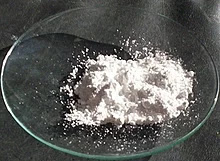What is titanium dioxide(TiO2)?
Titanium dioxide is a chemical compound with a chemical formula TiO2.
Titanium dioxide is composed of a barium cation and the sulfate anion. The sulfur is attached to four oxygen atoms. TiO2 is a sulfate salt of barium and is found as mineral barite. It is a crystalline solid white in colour which is insoluble in water and alcohol but soluble in concentrated acids. It is odourless.
Titanium dioxide is an alkaline, divalent metal. It is non-toxic and is safe for medical use. It is widely used in the production of oil and natural gas to get high-density drilling fluids by keeping the boreholes free of rock.
Structure of Titanium dioxide (TiO2)
Properties
The physical properties of titanium dioxide:
Molar mass: 79.8658 g · mol-1
Refractive index: 2.76 ~ 2.55
Mohs Hardness : 6-7, 5.5-6
Capacitance ratio: 114 to 31
The coefficient of linear expansion: 25 ℃
Thermal Conductivity: 1.809 to 10.3
Oil Absorption: 16 ~48,18 ~30
Particle size: 0.2 ~ 0.3, 0.3
Solubility: It is insoluble in dilute alkali, dilute acid, but soluble in hot concentrated sulfuric acid, hydrochloric acid, nitric acid. The solubility of titanium dioxide is related to solutes.
The relative density: In the commonly used white pigment, the relative density of titanium dioxide is minimum. Of the same quality white pigment, titanium dioxide surface area is the largest and pigment volume is the highest.
Permittivity: Because of high dielectric constant of titanium dioxide, it has excellent electrical properties. Anatase titanium dioxide's permittivity is lower, only 48.
Conductivity: Titanium dioxide with the performance of the semiconductor, its conductivity increased rapidly with increasing temperature, but also is very sensitive to hypoxia.
Melting and Boiling points: It can be transformed into rutile when anatase and plate titanium dioxide are at high temperatures, so melting and boiling points of the board of Rutile and anatase titanium dioxide actually does not exist. Only rutile titanium dioxide has a melting point and boiling point, rutile titanium dioxide, a melting point of 1850℃, the melting point in oxygen-rich is 1879℃. The melting point of titanium dioxide is related to the purity of the titanium dioxide.
Hydroscopicity: Although titanium dioxide has hydroscopicity, but not too strong. The hydrophilic is related to surface area. The surface area is more large, the moisture absorption is higher. The moisture absorption of titanium dioxide is relevant to the surface treatment and the nature too.
Thermal Stability: Titanium dioxide has a good thermal stability, the general amount of 0.01% to 0.12%.
The chemical properties of titanium dioxide:
Titanium dioxide is non-toxic and chemical properties is stable. It almost has no reaction with other material produce under normal temperature. It is a partial acid sexual oxide. It has no reaction with oxygen, hydrogen sulfide, sulfur dioxide, carbon dioxide and ammonia and is not soluble in water, fatty acids, other organic acid and weak inorganic acid except for alkali and hot nitric acid.
But, in some specific conditions, titanium dioxide can get reaction with some substance. For example, these reactions as follows:
1) Only in the circumstance of long time boiling can it be totally soluble in strong sulfuric acid and hydrofluoric acid. The reaction equation is as follows:
TiO2+ 2H2SO4 = Ti(SO4)2 + 2H2O
TiO2+ H2SO4 = TiOSO4 + H2O
TiO2 + 6HF = H2TiF6 + 2H2O
2) Titanium dioxide can melt in the alkali (sodium hydroxide, potassium hydroxide) or alkali metal carbonate (sodium carbonate, potassium carbonate). Any one of which i have mentioned with Titanium dioxide can be transformed into soluble acid titanate.
For example, Titanium dioxide and sodium hydroxide's reaction equation:
TiO2 + 4NaOH = Na4TiO4 + 2H2O
3) At high temperature, if a reductant (carbon, starch, petroleum coke) exists, titanium dioxide can be chlorinated into titanium tetrachloride by chlorine.The response equation is as follows:
TiO2 +2C +2Cl2 = TiCl4 + 2CO
4) Titanium dioxide under high temperature can be restored into Low-valent titanium compounds by hydrogen, na, mg, aluminum, zinc, calcium, and some elements of the constant. If we put the dry hydrogen into red titanium dioxide, it can get Ti2O3; In 2000 ℃ and 15.2 MPa of hydrogen, it also can get TiO. If the rutile titanium dioxide is injected into the plasma chamber, it will be reduced to titanium metal through hydrogen. Three reaction equations are as follows:
2TiO2 + H2 = Ti2O3 + H2O
TiO2 + H2 = TiO+ H2O
TiO2 + 2H2 = Ti + 2H2O
All these are all about titanium dioxide chemical formula and equations. It can be seen that the use of titanium dioxide is still very large. If you are looking for titanium dioxide, you can reference Shanghai Titanos Industry Co., Ltd, a professional titanium dioxide manufacturer, supplier and exporter with a factory in China.
Uses of TiO2
It is used in the casting of copper anode plates as a coating material.
It is used as a radiopaque agent.
It is used as a component in oil well drilling fluids.
It is used to increase the density of the polymer by acting as a filler for plastics.
Used to test the PH of the soil.
Used as a filler or to modify the consistency in oil paints.
It is used in imaging of the GI tract during barium meal.
Used to diagnose certain disorders of the intestines, stomach, or oesophagus.
It is used in the manufacturing of alloys.
Why is titanium dioxide in toothpaste?
Titanium dioxide (TiO2) is widely used to enhance the color and brightness of food items in white. TiO2 is also used in other products including toothpaste as a white pigment. Recent experiments with TiO2 show that these particles have the ability to have toxic effects.







0 Comments